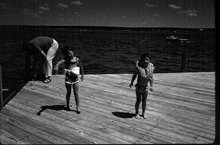
my grandmother, june c. 1939
--Dan Flores, Caprock Canyonlands
When you placed your ear against my great-grandmother’s chest, (borrowing Delia Falconer's image) you could hear waterfalls. It was thus that water became displaced by sky as the central metaphor for my existence. Not that water did not compete, or vie imperiously for its rightful place, it is just that sky became, overall, predominant.
She was a red-headed beauty and a dancer who gave lessons at the Crazy Water Hotel in Mineral Wells. He was a minor league baseball pitcher, Kid Callahan, and a notorious womanizer. After they married, my grandmother (who was maybe three or four at the time) recalls a fight over the aforementioned womanizing. Whether or not this played into the waterfall condition I don’t know, but they soon thereafter relocated to a more arid climate: thus, the sky.
The canyonlands are a mythical place, at least they once were. At one time there were no roads and to get to the canyon’s depths required a strenuous hike. My grandmother (pictured) was petite and fair, and once fainted from exhaustion on a summer walk down into the canyon and had to be carried out by her companions. When I was a child there were still a few remnants of the once-massive herds of buffalo.
We have begun again to cultivate the wild grasses that once shimmered across the plains. The little bluestem and grammas and buffalo grass. There are still coyotes, and (intermittently) the Sandhill Cranes. The cotton is still irrigated with water from the Red and Little Red rivers which carved the canyon over a million years ago and formed the Ogallala Aquifer.
Some sources seem too sacred to plunder. And yet, we do.



